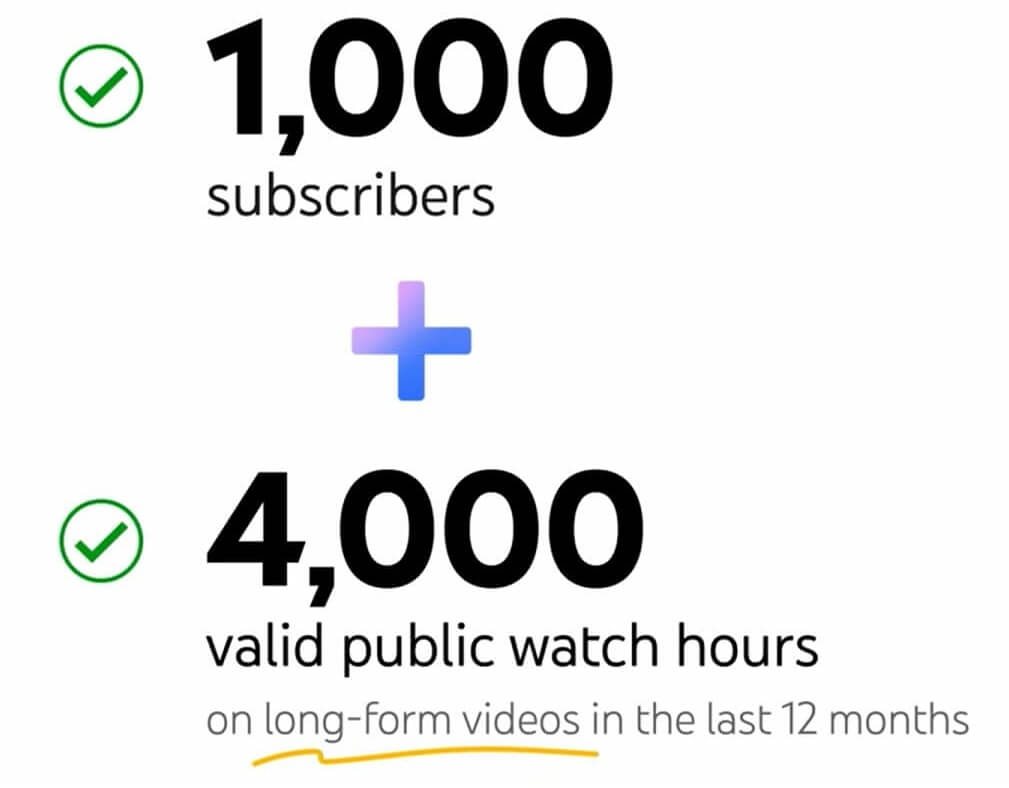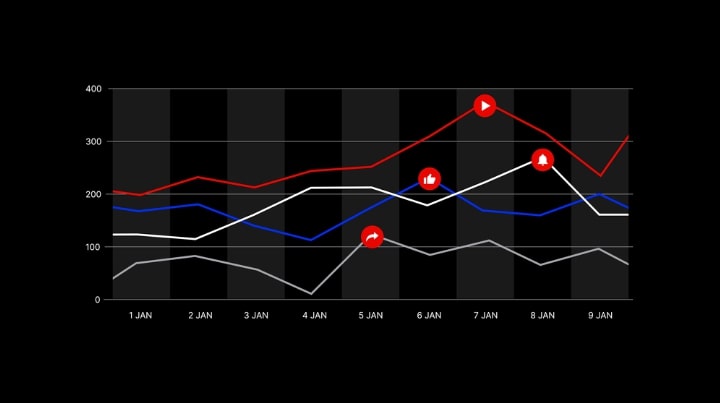Have you thought about what it’s like when your YouTube video hits 100,000 views? It’s not just about the thrill of being noticed; there’s money involved too. But figuring out exactly how much YouTube pays for those views isn’t simple. Many factors come into play. Let’s take a closer look at how YouTube’s payment system works and find out what you could actually earn from a viral video.
Outline
Toggle- YouTube’s Monetization Model For 100k Views
- How Much Does YouTube Pay Per View?
- How Much Money Is 100k Views On YouTube Shorts?
- How YouTube Shares Ad Revenue With Creators?
- Tips To Increase Your YouTube Earnings
- FAQs:
- Conclusion
YouTube’s Monetization Model For 100k Views
The YouTube Partner Program (YPP) provides creators with several avenues for earning money from their videos. To participate, creators must enable features like ad monetization, channel memberships, and merchandise sales. However, joining YPP requires meeting stringent guidelines, including a substantial viewership base, which underscores YouTube’s commitment to quality and sustainable content production.
Eligibility For 100k Views
To start earning, creators must meet the following YPP eligibility criteria:
- 4,000 watch hours over the past 12 months to demonstrate that the content engages viewers substantially.
- At least 1,000 subscribers to establish a consistent audience base.
- Adherence to YouTube’s community guidelines to ensure content is suitable for advertisers.
These criteria emphasize the importance of quality engagement over sheer view counts, fostering a healthy ecosystem for creators and advertisers alike.
Why Join The YouTube Partner Program?
Joining YPP opens up several revenue streams:
- Ad Revenue: The main source of income is from ads placed on your videos, which varies based on ad impressions and CPM rates.
- Enhanced Monetization Features: Allows earnings from channel memberships and merchandise sales.
- Access to Advanced Tools: Provides analytics and other tools to help creators optimize their content strategies and better understand their audience.
How Much Does YouTube Pay Per View?
YouTube does not pay a fixed amount per view. Instead, it compensates creators through a shared CPM model, where earnings per thousand views can vary widely based on different factors. Typically, creators might earn between $10 to $30 per 1,000 views, depending on these variables.
|
Views |
Potential Earnings |
|
10K views |
$100 – 300 |
|
100K views |
$1,000 – 3,000 |
|
500K views |
$5,000 – 15,000 |
|
1M views |
$10,000 – 30,000 |
The CPM (Cost Per Mille) Model
CPM, meaning cost per thousand impressions, directly influences earnings:
- Higher CPM results in more money per view, assuming ads are seen by viewers.
- Lower CPM means less income per view.
Calculation: How Much For 100k Views? (Estimation)
To estimate earnings from 100,000 views, consider a hypothetical CPM range:
- Low CPM Scenario: $1 per 1,000 views → $1 x 100 = $100
- High CPM Scenario: $3 per 1,000 views → $3 x 100 = $300
This calculation provides a potential earning range from $100 to $300 for 100k views, demonstrating the variability and the influence of multiple factors on potential income.
Factors That Significantly Influence CPM Rates
1. Niche Specificity and Advertiser Demand
Niche plays a disproportionately large role in influencing CPM:
- High-Value Niches: Channels focusing on finance, investing, or real estate typically attract higher CPMs. For example, a video discussing “investment strategies for tech stocks” might attract premium finance-sector ads.
- Mid-Value Niches: Tech reviews or educational content generally receive moderate CPMs. For instance, a detailed review of a new smartphone might attract ads from tech companies.
- Lower-Value Niches: General entertainment or vlogs often have lower CPMs because the audience is not as narrowly targeted compared to more specialized content.
2. Geographic Influence on Ad Rates
The viewer’s geographic location significantly affects CPM:
- Higher CPM Regions: Videos viewed in the United States, Canada, or the UK can command higher CPMs due to the higher purchasing power of viewers and the dense concentration of advertisers targeting these markets.
- Lower CPM Regions: Views from countries with lower advertising budgets or economic constraints typically yield lower CPMs.
3. Engagement and Ad Formats
Engagement metrics like watch time, likes, and comments can enhance a video’s visibility and attractiveness to advertisers:
- Engagement: A high engagement rate suggests that viewers are interested in the content, making them more likely to pay attention to ads.
- Ad Formats: Non-skippable and overlay ads tend to generate higher CPMs than skippable ads because they guarantee more direct exposure to the viewer.
Practical Examples and Potential Earnings
Estimating Earnings with Real-World Scenarios
- Example for High CPM: A finance channel that posts a well-timed video about “year-end tax saving tips” during tax season might see a CPM of $20, leading to earnings of approximately $2,000 for 100k views.
- Example for Moderate CPM: A tech review channel covering popular gadgets during a major release might earn a CPM of $10, thus making $1,000 for 100k views.
- Example for Low CPM: A vlogging channel might average a CPM of $2, resulting in $200 for 100k views.
Potential Earnings By Niche On YouTube Table
|
Niche |
RPM Rate |
100k Views On YouTube |
|
Business |
$8.07 |
$807 |
|
Finance |
$21.20 |
$2120 |
|
Fitness |
$2.4 – $3 |
$240 – $300 |
|
Gaming |
$0.5 – $5 |
$50 – $500 |
|
Lifestyle |
$9.72 |
$972 |
|
Tech |
$9.72 |
$972 |
|
Business |
$8.07 |
$807 |
How Much Money Is 100k Views On YouTube Shorts?
Monetizing YouTube Shorts differs significantly from regular videos. Instead of direct ad revenue, Shorts creators earn from a pooled revenue system where funds are distributed based on viewer engagement and geographic location. As a result, 100,000 views on Shorts do not correspond to a fixed earnings amount. The payout can greatly vary, typically ranging from $10 to $300 for 100,000 views, depending on the overall engagement and the competitive landscape among creators.
Tips to Boost Earnings from YouTube Shorts:
- Quality Content: Produce engaging Shorts that captivate viewers and encourage longer watch times.
- Consistency: Regular uploads help maintain visibility in feeds, increasing your chances of earning from the monetization pool.
- Build Engagement: Encourage viewers to subscribe and interact with your content to build a loyal following.
- Analytics: Utilize YouTube Analytics to track performance and refine your strategies for better outcomes.
How YouTube Shares Ad Revenue With Creators?
YouTube shares ad revenue with creators through its Partner Program. Once a creator meets the eligibility requirements (1,000 subscribers and 4,000 watch hours over the past 12 months), they can apply to the program. Here’s how the revenue sharing works:
- Ad Revenue: YouTube keeps 45% of ad revenue generated by the videos, while the creators receive 55%.
- Premium Revenue: Creators also earn a share of YouTube Premium subscriber fees when these subscribers watch their content.
Factors affecting your share:
- CPM Rate: This varies depending on the factors mentioned earlier (niche, viewer location, engagement). A higher CPM means you earn more per impression.
- Ad Format: Skippable ads typically pay less than non-skippable ones.
- Number of Impressions: The more times ads are displayed on your video (due to factors like watch time), the more opportunities you have to earn.
Tips To Increase Your YouTube Earnings
Building a successful YouTube channel that generates substantial income requires dedication, creativity, and strategic planning. Here are some tips to consider:
- Creating High-Quality Content: This is the foundation of everything. Focus on creating engaging and informative videos that resonate with your target audience.
- Optimize the video titles and descriptions: Use relevant keywords to help viewers find your content through search. Clear and concise descriptions entice viewers to click on your videos.
- Promote Videos On Social Media: Share your videos on other social media platforms to drive traffic to your YouTube channel.
- Collaborate with other YouTubers: Collaborations can expose you to new audiences and potentially lead to increased viewership and engagement.
- Monitoring and Adapting Strategies: Track your channel’s performance using YouTube Analytics. Analyze what content resonates best with your audience and adapt your strategy accordingly.
- Engage with Audience: Respond to comments, answer questions, and participate in discussions. Building a strong connection with your viewers fosters loyalty and encourages them to keep coming back for more.
FAQs:
Ans: Yes and no. While viewers with YouTube Premium subscriptions won’t see ads on your videos, YouTube still shares a portion of their subscription fees with creators they watch. The more watch time you generate from Premium members, the more you earn. So, it doesn’t directly reduce your income, but it might affect how much you earn from ads on those specific views.
Ans: YouTube payments are typically issued around the beginning of each month. However, there’s a minimum threshold you need to reach before receiving a payout. This threshold can vary depending on your location and chosen payment method.
Ans: No, YouTube doesn’t directly pay for likes, comments, or shares. Your revenue comes from ads displayed on your videos. However, high engagement (likes, comments, watch time) can attract better-paying ads and potentially increase your earnings per view.
Ans: After you reach the minimum payout threshold, it can typically between the 21st and 26th of every month through AdSense.
Ans: Yes, YouTube has sophisticated systems in place to detect and filter out fake views. If YouTube detects suspicious activity on your channel, they may remove those views and impact your overall earnings. It’s important to focus on creating high-quality content that attracts genuine viewers for sustainable growth.
Conclusion
The amount YouTube pays for 100k views isn’t fixed; it varies based on the kind of ads, who’s watching, and how much viewers interact with the content. To earn more, it’s important to focus on creating high-quality, engaging videos that appeal to a specific niche. Consistent effort and creativity can turn YouTube into a profitable outlet for those who are passionate about their content.




